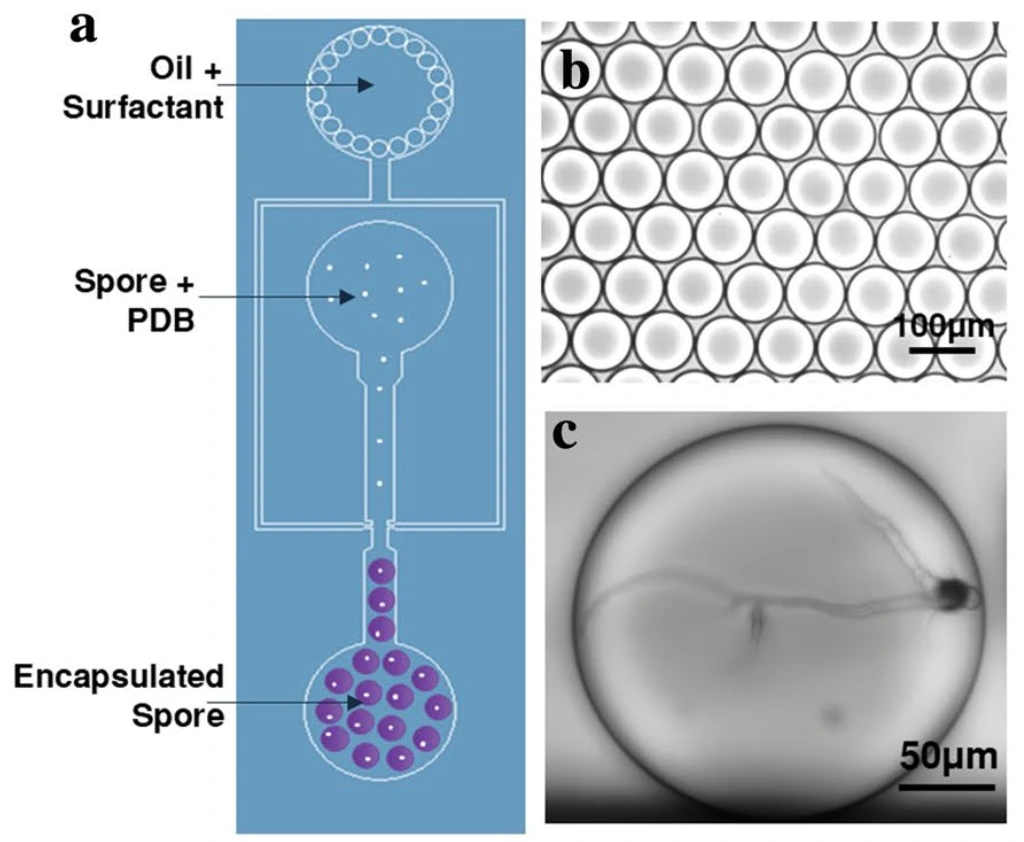Our microfluidic skills: Encapsulation
Author
Camila Betterelli Giuliano, PhD
Publication Date
February 27, 2025
Keywords
Droplet microfluidics
monodisperse droplets
Single-cell encapsulation
4D printing
Artificial cells
confined compartments
nanoparticle optimisation
Your microfluidic SME partner for Horizon Europe
We take care of microfluidic engineering, work on valorization and optimize the proposal with you
Droplet microfluidics
Microfluidics not only allowed the production of controlled and monodispersed droplets, it allowed researchers to use these droplets as tiny reservoirs to isolate single cells and other particles. Imagine the orders of magnitude in resolution gain that became possible when we moved from bulk observations to analysis of individual cells. That’s the power of encapsulation.
And, of course, we could not let this powerful technique slide by us. The MIC is implicated in several encapsulation projects in a variety of applications, as you can see below.

DarChemDN, Darwinian Chemistry in Droplets

Mixing microfluidics and chemistry results in a whole new field of study: evolutionary chemistry.
The goal is to create self-replicating inorganic molecules by encapsulating autocatalytic systems in confined compartments (GA no. 101119956).
The MIC provides the microfluidics expertise to produce high-throughput monodisperse droplets encapsulating these systems. If you want to know more, visit the project’s page here.
NAP4DIVE, nanoparticle optimisation to cross the blood-brain-barrier

Crossing the blood-brain-barrier to deliver drugs to the brain is still very challenging. The goal of the NAP4DIVE project is to test different types of nanocompartments encapsulating compounds of interest and optimised for membrane crossing, in a bbb-on-chip model (GA no. 101155875).
The MIC is responsible for developing the microfluidic circuit that feeds the cells inside bbb-on-chip and carries the nanoparticles until the membrane. If you want to know more about the project, visit the project page.
Bio-hHost, artificial cells to influence living cell interactions

Cells are in constant interaction with one another. The Bio-hHost project wants to understand these interactions in depth by creating realistic 3D tissue models that mix artificial cells and living cells (GA no. 101130747).
The MIC is in charge of developing the platform that will keep the 3D tissue models in good condition on top of the microscope stage without the need for a CO2 incubator or incubator chamber. Get to know more about the project following the link!
Voxwrite, 4D printing with microfluidics

Additive manufacturing, especially 3D printing, has become a consolidated technology in construction and prototyping. The Voxwrite project wants to take it one step further, using droplet-based microfluidics to design complex 4D materials (project no. ANR-23-CE10-0018-02).
The MIC is developing the microfluidic sequential injection device to produce resin droplets with varying compositions and employ them in 4D printing processes. To know more about Voxwrite, follow the link!
References
- Iftikhar, S., A. Vigne, and J.E. Sepulveda-Diaz, Droplet-based microfluidics platform for antifungal analysis against filamentous fungi. Scientific Reports, 2021. 11(1): p. 22998.
Want us as partners in your project for 2026-2027 call?
Curious what's next? Sign up for our Newsletter
FAQ – Encapsulation
How would you define the term encapsulation in microfluidics?
The entrapment of cells, spores, enzymes, or nanoparticles in a droplet with a diameter of a microscope is known as encapsulation. The droplets act as tiny reservoirs, isolating discrete cells and other particles. They are convenient when you require a controlled environment and repeatable readouts.
Why not use the droplets instead of bulk experiments?
There are two words, resolution and control. Droplet microfluidics provides single-event isolation (individual cells, individual spores, individual reactions) and monodisperse compartments. You dispose of cross-talk and of statistics which are statistics of actual heterogeneity, not averages, in comparison to bulk.
What are the advantages of droplet generation?
- Big monodispersive droplets of nearly the same size.
- Internal chemistry, composition, and boundaries were very strictly controlled.
- The droplets act as a microenvironment with a small cross-talk and measurement.
In what kind of projects do you use the encapsulation skills?
Here are a few examples:
- DarChemDN (“Darwinian Chemistry in Droplets”): an experiment using encapsulated autocatalytic chemical systems to study the dynamics of molecule self-replication.
- NAP4DIVE: optimizing nanoparticles that can cross the blood-brain barrier, using droplet systems to screen and test them.
- Bio-hHost: the creation of artificial cells capable of interfering with living cells in three-dimensional tissue constructs.
- Voxwrite: microfluidic droplet generation and 3D printing of complex materials (also known as 4D printing).
What is the best way to prepare high-throughput, uniform droplets of chemical or biological systems?
High-throughput, monodisperse droplets, i.e., droplets that are almost exactly the same size and composition, are produced using high-throughput, precision microfluidic circuits. This enables isolated reactions, single-cell experiments, and chemical self-replication experiments to be performed in an extremely controlled and reproducible way.
DarChemDN experiments on chemical self-replication and evolution with isolated droplet reactors. MIC offers the microfluidics expertise to manufacture the monodisperse droplets that entrap these chemical systems.
What are “artificial cells”?
Artificial cells are droplet-sized compartments designed to replicate some behaviors of real biological cells (e.g., reactions within, material exchange). They enable us to examine the behavior of chemical networks or synthetic systems under so-called pseudo-cellular conditions. In 3D tissue models, we keep the constructs in constant environments on the microscope stage, without a large CO2 incubator, and can make long acquisitions without transporting the sample.
What is the method of culturing sensitive 3D tissue or artificial cell systems on a microscope?
We build miniature, in-built systems, which regulate temperature, gas, and humidity directly on the microscope stage. This can provide live imaging of sensitive 3D tissues or artificial cells in the absence of a conventional CO2 incubator and stabilize a typical physiological microenvironment. This enables real-time imaging and preservation of tissue well-being.
Bio-hHost aims to develop artificial cells that would alter the interactions of living cells.
Is it possible to integrate such droplet systems into other systems, e.g., organ-on-chip systems?
Yes. An example is the NAP4DIVE project, which uses droplets laden with nanoparticles to investigate transport across a blood-brain barrier (BBB) chip.
How do you combine the concept of droplet generation with high-tech manufacturing, e.g., 4D printing?
Voxwrite combines microfluidics and 4D printing. MIC develops a sequential microfluidic injection instrument that generates resin droplets of different compositions. These droplets are then put through 4D printing to create programmable materials.
Is automation advantageous to encapsulation?
Encapsulation is well matched with automated control and machine-learned readouts, such as adaptive flow control, image-based quality checks, and quick droplet contents classification.
I’m building a Horizon Europe consortium. What role can MIC play?
MIC is a French SME specializing in microfluidic engineering and automation. We routinely co-lead the microfluidic work packages (design, prototyping, validation) and help with integration across biology, chemistry, and data. As an SME participating in several EU consortium tenders, our participation generally enhances the value chain logic and measurables, and, yes, in reality, that considerably contributes to raising the competitiveness of proposals.